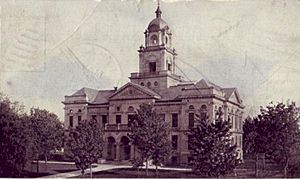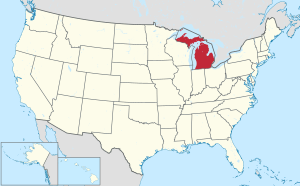Gratiot County, Michigan facts for kids
Quick facts for kids
Gratiot County
|
||
|---|---|---|

|
||
|
||

Location within the U.S. state of Michigan
|
||
 Michigan's location within the U.S. |
||
| Country | ||
| State | ||
| Founded | 1855 | |
| Named for | Charles Gratiot | |
| Seat | Ithaca | |
| Largest city | Alma | |
| Area | ||
| • Total | 572 sq mi (1,480 km2) | |
| • Land | 568 sq mi (1,470 km2) | |
| • Water | 3.1 sq mi (8 km2) 0.6%% | |
| Population
(2020)
|
||
| • Total | 41,761 |
|
| • Density | 75/sq mi (29/km2) | |
| Time zone | UTC−5 (Eastern) | |
| • Summer (DST) | UTC−4 (EDT) | |
| Congressional district | 2nd | |
| Website | https://www.gratiotmi.com/ | |
Gratiot County (pronounced GRASH-it) is a county in the state of Michigan. In 2020, about 41,761 people lived here. The main town, called the county seat, is Ithaca. However, the biggest city in the county is Alma.
Gratiot County is part of a larger area that includes Mount Pleasant. The Gratiot County Courthouse is a beautiful old building. It was designed by Claire Allen, a famous architect from southern Michigan. This courthouse is one of seven places in the county that are listed on the National Register of Historic Places. In 2012, a very large wind power project opened here. It was the biggest wind farm in Michigan at the time.
Contents
History of Gratiot County
Gratiot County is named after Captain Charles Gratiot. He helped build Port Huron's Fort Gratiot. The area was first described by the Michigan government in 1831. Michigan became a state in 1837. Then, in 1855, the state officially created Gratiot County. This was the same year Captain Gratiot passed away.
Early Settlers and Their Journey
Many of the first people to settle in Gratiot County came from New England. These "Yankee" settlers were descendants of English Puritans. Their families had first arrived on the northeastern coast of America in the 1600s.
These early settlers were farmers. They traveled west into the wild lands of the Northwest Territory in the early 1800s. Many came after the Erie Canal was finished. They also arrived after the Black Hawk War ended. They found thick forests and open prairies. But they worked hard to create farms, build roads, and set up government buildings.
Culture and Values of the First Settlers
The settlers kept their old customs and beliefs. They strongly believed in the importance of education. They also hated the idea of slavery. Most of them belonged to the Congregationalist Church or the Episcopal Church.
In the 1890s, many German immigrants also began to settle in Gratiot County. Emil Lockwood, a well-known Michigan politician, represented Gratiot County. He served in the Michigan Senate from 1963 to 1970. For much of that time, he was the Senate Majority Leader.
Historical Markers in Gratiot County
There are six special historical markers in Gratiot County. These markers tell about important places and events:
- Alma College
- Gratiot County
- Jackson Weller House
- Lumberjack Park
- Michigan Masonic Home
- Saginaw and Gratiot County State Road / Saginaw Valley & St. Louis Railroad
Geography of Gratiot County
Gratiot County covers about 572 square miles. Most of this area is land, about 568 square miles. Only a small part, about 3.1 square miles, is water. This means about 0.6% of the county is water. Gratiot County is located in what is known as Central Michigan.
Neighboring Counties
Gratiot County shares its borders with several other counties:
- Midland County – to the northeast
- Isabella County – to the northwest
- Saginaw County – to the east
- Montcalm County – to the west
- Shiawassee County – to the southeast
- Clinton County – to the south
- Ionia County – to the southwest
Main Roads in Gratiot County
Several important highways run through Gratiot County:
 US 127 – This road goes north to I-75 and south to Lansing.
US 127 – This road goes north to I-75 and south to Lansing.


 Bus. US 127 – A special loop road through downtown Alma.
Bus. US 127 – A special loop road through downtown Alma.


 Bus. US 127 – A special loop road through downtown Ithaca.
Bus. US 127 – A special loop road through downtown Ithaca.


 Bus. US 127 – A special loop road through downtown St. Louis.
Bus. US 127 – A special loop road through downtown St. Louis. M-30 – This highway goes north into Midland County and continues to West Branch.
M-30 – This highway goes north into Midland County and continues to West Branch. M-46 – This road crosses the state. It goes east to Saginaw and Port Sanilac. It goes west to Muskegon.
M-46 – This road crosses the state. It goes east to Saginaw and Port Sanilac. It goes west to Muskegon. M-57 – This road goes east to Flint. It goes west to US 131 near Grand Rapids.
M-57 – This road goes east to Flint. It goes west to US 131 near Grand Rapids.
Population of Gratiot County
| Historical population | |||
|---|---|---|---|
| Census | Pop. | %± | |
| 1860 | 4,042 | — | |
| 1870 | 11,810 | 192.2% | |
| 1880 | 21,936 | 85.7% | |
| 1890 | 28,668 | 30.7% | |
| 1900 | 29,889 | 4.3% | |
| 1910 | 28,820 | −3.6% | |
| 1920 | 33,914 | 17.7% | |
| 1930 | 30,252 | −10.8% | |
| 1940 | 32,205 | 6.5% | |
| 1950 | 33,429 | 3.8% | |
| 1960 | 37,012 | 10.7% | |
| 1970 | 39,246 | 6.0% | |
| 1980 | 40,448 | 3.1% | |
| 1990 | 38,982 | −3.6% | |
| 2000 | 42,285 | 8.5% | |
| 2010 | 42,476 | 0.5% | |
| 2020 | 41,761 | −1.7% | |
| 2023 (est.) | 41,368 | −2.6% | |
| US Decennial Census 1790-1960 1900-1990 1990-2000 2010-2018 |
|||
In 2000, there were 42,285 people living in Gratiot County. There were about 14,501 households. A household is a group of people living together. About 10,397 of these were families.
The population density was about 74 people per square mile. Most people in the county were White (92.01%). Other groups included Black or African American (3.72%) and Native American (0.55%). About 4.43% of the people were Hispanic or Latino.
Most people spoke English at home (96.1%). A smaller number spoke Spanish (2.7%). About 34% of households had children under 18 living with them. The average household had 2.57 people. The average family had 3.02 people.
The median age in the county was 36 years old. This means half the people were younger than 36, and half were older. For every 100 females, there were about 108 males.
Religion in Gratiot County
The main group for the Catholic Church in this area is the Roman Catholic Diocese of Saginaw.
Communities in Gratiot County
Gratiot County has several different types of communities.
Cities
Villages
Unincorporated Communities
These are smaller places that are not officially cities or villages.
Ghost Towns
These are places where people used to live, but now they are empty or abandoned.
- Bridgeville
- Langport
- Ola
Townships
Townships are smaller government areas within the county.
- Arcada Township
- Bethany Township
- Elba Township
- Emerson Township
- Fulton Township
- Hamilton Township
- Lafayette Township
- New Haven Township
- Newark Township
- North Shade Township
- North Star Township
- Pine River Township
- Seville Township
- Sumner Township
- Washington Township
- Wheeler Township
Education in Gratiot County
The Gratiot–Isabella Regional Education Service District helps students in Gratiot County. It is based in Ithaca. This district offers special education services and programs for young children. It also provides training for technical careers.
Public Schools
Gratiot County has several public school districts:
- Alma Public Schools
- Ashley Community Schools
- Breckenridge Community Schools
- Fulton Schools
- Ithaca Public Schools
- St. Louis Public Schools
Private Schools
Gratiot County also has private schools:
- Countryside Christian School (run by Mennonite community)
- Ithaca SDA School (run by Seventh-day Adventist community)
- St. Mary School (run by the Roman Catholic community)
See also
 In Spanish: Condado de Gratiot para niños
In Spanish: Condado de Gratiot para niños


